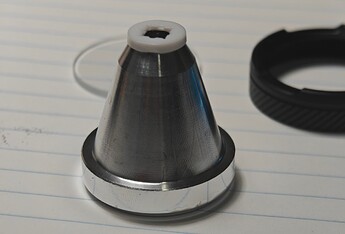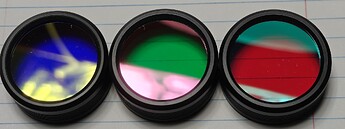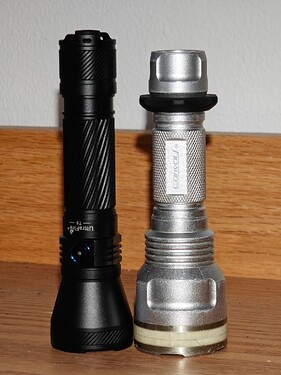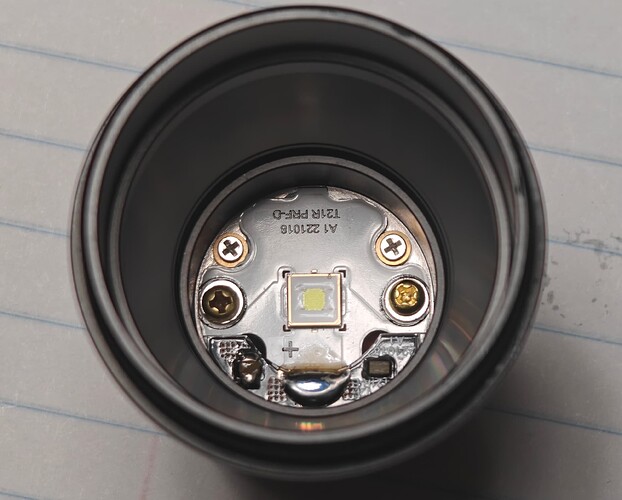This review is of a sample of Ultrafire T6, kindly provided in a giveaway by @UltraFireOfficial. Aside from the light itself, I receive no compensation for the review.
The light is a compact dual-switch thrower featuring USB-C charging and a protected 5000mAh 21700 cell, plus three friction-fit RGB filters.
Unboxing and basic observations
The light arrives in a box and is surrounded by foam. Also included in the foam are 3 filters, a charging cable, a user manual, a clip on the light, a lanyard, and a spare O-ring. There is no damage from shipping whatsoever.
The build quality appears to be good. The machining is of good quality, with no noticeable marks, sharp edges, or nicks and bumps. The anodizing is on the glossy side, but appears durable.
The battery tube is unanodized on both ends with rectangular/trapezoidal threads, and is in fact reversible! The clip on the battery tube is a snap-on type and very difficult to take on/off; as long as it does not break, it would be very effective at retaining the light.
The forward switch stands very proudly above the plane of the tailcap, making tailstanding impossible. Not really an issue for this type of light. The switch has a doubled spring for reduced resistance–very nice attention to detail!
User interface
The light has two switches: a tail forward clicky that controls physical connection of the electrical path, and a side e-switch for mode switching. Whenever the tail-switch is connected, momentary or fully on, pressing the e-switch cycles between moon, med, and high, with memory. Pressing and holding from any mode immediately enters variable-frequency strobe.
The side-switch has a built-in charging/battery indicator. The battery indicator turns on briefly when the light is on, with the correspondence
- Green: 50-100%
- Yellow: 20-50%
- Red 5-20%
- Flashing red: <5%
In practice, the indicator appears to underestimate battery level, as yellow is displayed when the battery measures 4.0V by multimeter. I think this is not a big deal and preferable to overestimation.
Optical assembly
The light features a Luminus SFT40 emitter in cool white. The tint is clean with no green tinge.
The reflector on this light is quite a curiosity, with a very high depth-to-width ratio; the last lights I’ve seen with such a deep reflector were the Maglite 2AA LED, and the venerable Defiant Super Thrower. Compared to a shallower reflector of equal diameter, a deep reflector yields marginally more throw at the expense of a narrower spill. The corona surrounding the hotspot is unusually large due to the geometry, with around 6x the hotspot radius.
There are a few specks of dust on the reflector, but they do not affect performance and were easily removed with silicone magic tape. The beam is clean with no rings or artifacts–indicating excellent quality of the reflector, as well as focusing and centering–and very throwy for the size. The hotspot is barely larger than that of the C8 running the same SFT40 emitter.
Charging and accessories
The light has a type-C charging port protected by a rubber cover. The charging rate can be selected by the user: 1.5A when the tail switch is off, or 3A when the tail switch is on, as measured by my type-C tester. The main emitter does not come on during charging if the tail switch is on.
Unfortunately, the algorithm appears to slightly overcharge the battery: upon immediate removal at termination of charge, the battery read 4.260V on my multimeter; usually, a fresh cell should have an off-the-charger voltage below 4.22V, which declines over time to 4.2V.
The provided battery is button top with protection circuit and 5000mAh rating. I don’t think the protection current is stated anywhere, and do not have the equipment to test this or the capacity. There is a physical reverse-polarity protection ring on the driver, so it is likely that flat-top cells won’t work.
The filters are friction-fit to the front of the light, and work well. The material of the filters is very interesting to me–they appear to be made from dichroic glass, eliminating unwanted wavelengths by reflection rather than absorption. This is an excellent engineering decision, which avoids the overheating issue that comes with absorption and marginally increases output as the reflected light refocuses onto the emitter.
Performance
I have a C8 with SFT40 5000K and 8A buck driver for comparison. Based on a ceiling bounce test (which should be valid due to similar beam profile), the T6 exactly matches the luminous flux of the C8, so the stated 1800lm is credible.
An intensity test at around 10m puts the intensity at just a hair under 2/3 that of the C8. A C8 with SFT40 5000K and 8A driver can be expected to achieve 800m of throw, which puts the T6’s distance at around 650m, significantly greater than the stated 550m!
Attempted teardown
The bezel twists loose and allows access to the reflector assembly and eventually the LED:
Unfortunately, I was not able to disassemble further from here. The MCPCB appears to be soldered to the driver PCB, and held down by 2 brass screws off to the side. The brass screws appear to be part of the electrical path, since loosening them prevents the light from turning on. It’s unclear what the two smaller screws do off to the side, as I did not have a screwdriver this small.
Overall quite an unusual MCPCB layout, and I believe that modding is out of the question except by the most skilled in electronics work.
Concluding remarks
It’s hard to reduce things down to a single rating number, given that every user has their own set of priorities. Instead of a rating, I will list items that I personally like and items that I think can be improved.
What I like:
- 40% more intensity than advertised!
- Excellent quality of the entire optical assembly
- Dichroic glass filters
- Reversible battery tube
What I think can improve:
- Update the charging algorithm to terminate at a lower voltage
- User interface: there is a ton that can be done with such a dual-switch setup. I think something like Anduril Simple Mode would be good, being accessible while offering a greater customizability, such as more mode choices.
- The e-switch rattles a tiny bit, which I suspect might impact its water resistance. Redesigning the switch (perhaps by adding a silicone cover that can be tightened) would be a good idea as the waterproofing elsewhere is virtually perfect.
Thank you for reading!






